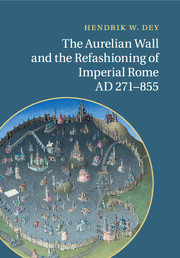Book contents
- Frontmatter
- Contents
- List of abbreviations
- List of figures
- Acknowledgements
- Introduction
- 1 Toward an architectural history of the Aurelian Wall, from its beginnings through the ninth century
- 2 Planning, building, rebuilding, and maintenance: the logistical dynamics of a (nearly) interminable project
- 3 Motives, meaning, and context: the Aurelian Wall and the late Roman state
- 4 The city, the suburbs, and the Wall: the rise of a topographical institution
- 5 Sacred geography, interrupted
- 6 The Wall and the “Republic of St. Peter”
- Conclusion
- Appendices
- Appendix A Numerical data
- Appendix B The fourth century revisited: the problem of Maxentius
- Appendix C The post-Honorian additions to the Porta Appia and other fifth- and sixth-century construction
- Appendix D The Aurelian Wall and the refashioning of the western tip of the Campus Martius
- Appendix E The Pons Agrippae and the Pons Aureli: a tale of two bridges
- Bibliography
- Index
Appendix B - The fourth century revisited: the problem of Maxentius
Published online by Cambridge University Press: 19 May 2011
- Frontmatter
- Contents
- List of abbreviations
- List of figures
- Acknowledgements
- Introduction
- 1 Toward an architectural history of the Aurelian Wall, from its beginnings through the ninth century
- 2 Planning, building, rebuilding, and maintenance: the logistical dynamics of a (nearly) interminable project
- 3 Motives, meaning, and context: the Aurelian Wall and the late Roman state
- 4 The city, the suburbs, and the Wall: the rise of a topographical institution
- 5 Sacred geography, interrupted
- 6 The Wall and the “Republic of St. Peter”
- Conclusion
- Appendices
- Appendix A Numerical data
- Appendix B The fourth century revisited: the problem of Maxentius
- Appendix C The post-Honorian additions to the Porta Appia and other fifth- and sixth-century construction
- Appendix D The Aurelian Wall and the refashioning of the western tip of the Campus Martius
- Appendix E The Pons Agrippae and the Pons Aureli: a tale of two bridges
- Bibliography
- Index
Summary
While the rudiments of a comfortable reconciliation between archaeology and written sources have at last been established for the primary stages of the Wall's construction, problematic issues remain, some of which have hardly been raised to date, much less resolved. The majority of the difficulties relate to the sections of the Wall that do not belong to the two principal building campaigns of Aurelian and Honorius, the most ancient of which, executed in opus vittatum, have come generically to be attributed to Maxentius, for the motives discussed above in Chapter 1. The identification, however, is neither as certain nor as straightforward as has been suggested.
A first problem is that many of the vittatum interventions in the Wall now often confidently ascribed to Maxentius diverge markedly in their technical characteristics. Some of them, indeed, resemble securely dated high- and late-medieval work far more than other tracts of vittatum in the Wall or, for that matter, in the buildings of Maxentius' villa. A second question, raised before but never, to my mind, satisfactorily resolved, relates to the sheer extent of many of the putatively Maxentian repairs, particularly in the northern sectors of the Wall, and above all to the towers, several of which have been refaced almost from the ground up in vittatum. Even given the concerns voiced about the occasionally deficient bonds between the Aurelianic brick facings and the concrete core behind, this seems a remarkable amount of decay to have occurred in the three decades between the completion of the Wall and the reign of Maxentius, particularly as the upper sections of several of these towers were rebuilt for their entire thickness, and not simply on their exterior surfaces.
- Type
- Chapter
- Information
- Publisher: Cambridge University PressPrint publication year: 2011



